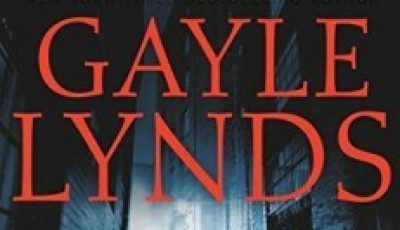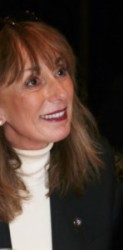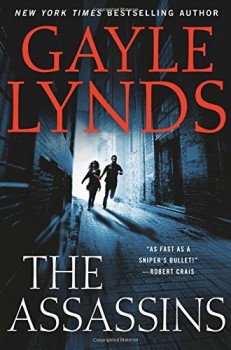

Between the Lines Interview with New York Times bestselling author Gayle Lynds
She’s been called the “female Robert Ludlum” and the “Queen of Espionage.” She’s broken barriers for women in fiction, and co-founded one of the world’s leading organizations for writers. And, oh yeah, she writes kick-ass New York Times bestsellers.
You guessed it, she’s Gayle Lynds, and this month, she’s back with a vengeance with THE ASSASSINS (St. Martin’s Press, June 30).
On the heels of her smash hit The Book of Spies, this latest story is about what happens when two spooks get caught in the crossfire of a business dispute—one involving six of the world’s most deadly assassins. Part heist story, part espionage thriller—one hundred percent adrenaline—THE ASSASSINS should go down as Lynds’s best novel to date. And that’s saying something given that her work is on Publishers Weekly’s list of the top ten spy thrillers of all time.
What’s special about Lynds, though, is that when she’s not crafting page-turning thrillers or hiking in beautiful Maine, she’s helping aspiring authors. She’s a true writer’s writer, and it is no surprise that the International Thriller Writers, the organization she co-founded, carries forward her spirit of kindness, support, and mentorship.
Lynds graciously agreed to answer a few questions about THE ASSASSINS and her life and career.
THE ASSASSINS. Wow. I couldn’t put it down. As I said, the novel is part suspenseful heist story, part edge-of-your-seat espionage thriller, and part battle of wits among six professional killers. What inspired the tale?
Thank you for your kind words, Anthony. I like the way you encapsulate THE ASSASSINS. I love adventure and geopolitics, and as a result I’ve been writing for years about spies. This time, I wanted an equal amount of focus on a critical footnote—professional international assassins.
Your six assassins—the aging de facto leader Burleigh Morgan, the Basque, the Russian, the former jihadist, the retired Mossad operative, and the Cosa Nostra killer—are all master killers. They’re also very different people, bucking the common movie stereotype of assassins as one-dimensional killers. How did this interesting diversity of character come about?
Assassins fascinate me. For many of them, it’s simply a business, while others are driven by ideology. The truly insane don’t last decades, as these men have. It seemed to me their characters could be the basis for a compelling story. As it turns out, the six in my book work together only once, and that’s for Saddam Hussein. Then Saddam stiffs them—doesn’t make his last payment. So as America and the coalition are invading Iraq in 2003, the assassins slip into Baghdad to get what’s theirs. Fast forward to 2015, and someone has discovered their shared past and forces them into a game of last-man-standing. I really enjoyed pitting the best-of-the-best—legendary experts in all ways to manipulate and kill—against each other.
One of your protagonists, Judd Ryder, is a former U.S. Army spy, and the other is Eva Blake, a CIA trainee. Tell us about them.
Judd and Eva hold the story of the six assassins together. It’s their job, Judd’s in particular, to lead us on the hunt among the killers. Both are composites of several spies I’ve known who had the talent and intellect to become exceptional. They have something I call gut. It’s more than brains and giftedness—it’s a kind of espionage star quality that gives them the ability to see beyond the obvious and even the hidden to know that there’s something missing, something that appears to fit but really doesn’t, something awful. I admire that a lot. By the way, I enjoyed being in Judd’s and Eva’s heads a lot and miss them even now.
As a reader, you almost feel like you’re walking the perilous streets of Baghdad or strolling modern D.C. I know your son, a prominent lawyer, lives in the D.C. area, but have you been to Iraq? To Marrakech? If not, how’d you manage such authentic scenes?
As you know, I’m a research freak. Alas, I haven’t been to Baghdad or Marrakech, but “I know people who have.” That’s an inside joke of course, what spies will say when they want to dismiss a question about which they actually have first-hand knowledge. But I’m telling the truth, no lie—I haven’t been either place. Really. Truly. Never.
Speaking of research, THE ASSASSINS required knowledge of ancient artifacts, post-war Iraq, spy tradecraft, weapons, and even pop culture. How ever did you research this one?
I must’ve spent a year in research, and of course the research continues as one is writing. I read a lot of nonfiction books, clip articles out of magazines and newspapers, poke around the Internet for days and print out the best stuff, and chat with folks who are kind enough to fill me in. Without realizing it, I’ve become an autodidact. School was really hard for me, because my memory vanished around eighth grade. My curiosity not only got me into trouble, it kept me going. The result is shelves of books and file cabinets of clippings. Something that entertains me is finding a clipping from ten or even twenty years ago that all of the sudden is useful. So I sneeze off the dust and use it fast.
You’ve been a writer in some form or other for more than thirty years—including jobs as an investigative journalist, a pulp fiction and YA author, an editor of a think tank—until ultimately you became known as the “Queen of Espionage.” In your long career, what was the biggest high and biggest low you faced?
One of my lowest points was the unfortunate review Publishers Weekly gave my first novel, Masquerade. One of the highest points was several years later, when it listed Masquerade as one of the top ten spy novels of all time. That was sweet. It was a book that readers loved, and I did, too. But when that first review came out—the first of my career—I was devastated. It’s a lesson I never forget—reviews are one person’s opinion, and not everyone is going to like what one writes. P.S. I sure wish they would, though.
I hear Kurt Vonnegut is to blame for your job working at a think tank where you had a top-secret security clearance?
I’m a graduate of the University of Iowa. While I was there, I was fortunate Kurt Vonnegut was in residence. By then he’d published Cat’s Cradle¸ a wonderful short novel about a man with a Midas touch—but in his case, objects weren’t turning into gold. Strangely and wondrously, they became ice. I asked Kurt where he got such a crazy idea, and he explained that one summer he found a job at a think tank as an editor. Ideas bounced off the walls, he said, and he just grabbed one and massaged it into Cat’s Cradle. So when I moved to Santa Barbara, I was offered a job at a think tank where I’d eventually get Top Secret security. You can just imagine how quickly I said yes.
Someone once said that, beyond the blank page, a writer’s worst fear is having several characters in the same room. Yet your story centers on six assassins. How did you so seamlessly write with multiple characters in the amazing opening scenes? Any tips for writers out there?
It’s tough to write multi-character scenes, and I don’t love them anymore than anyone else. For me, the most important part is to make certain the reader isn’t confused. In the opening scene, which takes place in Baghdad in the Iraq National Museum where the assassins have gone to steal a stone tablet, I decided we didn’t need anyone’s name, except for the lead assassin. That meant that I had one name—and five assassins who could be known by their backgrounds, which you so cleverly identified earlier in the interview. I liked that. It made my job easier, and then as the assassins appeared one by one later in the novel, the reader already had a sense of them.
Since we’re talking writing tips, you teach at ITW’s writing school, CraftFest, and have taught many other courses over the years. If you had to pick one piece of advice over any other for new writers—focused purely on craft—what would it be?
Learn the so-called rules, and learn them well. Then, once you have them solidly in hand, break them. By breaking rules well, you break new literary ground for yourself and you surprise and delight your readers.
Earlier in your career, you co-wrote books with Robert Ludlum before it became common for mega authors to work with co-writers. How did that come about?
In those days, I was being called the female Robert Ludlum. I was told Bob was reading my work and liked it so much he wanted to invite me to develop a basic idea he had into a series, and to write the first book. That was The Hades Factor, which was made into a CBS miniseries. I went on to write a couple more of the books and then retired. It was great fun, and I’ve always been grateful for the opportunity. Several writers followed, including Jamie Freveletti. She’s a terrific author.
How has the spy thriller changed from when you started out and with the end of the Cold War?
My first one, Masquerade, was published in 1996 when the Cold War was considered dead, dead, dead, and 9/11 was five years away. The New York Times had stopped publishing its regular spy thriller review column. John le Carre and Frederick Forsyth were moving on to other genres. But I still saw a great richness in the espionage field and plowed onward. Then 9/11 changed everything. There was finally a focus again—terrorism. The spy thriller made a sharp turn and reinvented itself. The world is dynamic, always changing. Still, some writers today remain steadfast in writing only about terrorism. God knows it’s a huge topic, but I like to move around and do other things, like geopolitics. For instance, in THE ASSASSINS, the ultimate plot is to join Iraq and Iran into one nation, which looks more and more possible these days.
If you could go back to the beginning and give yourself some advice from what you’ve learned as a bestselling author, what would it be?
Relax and enjoy the roller coaster. The dips are deep. The highs are high. In the end, all that matters is the work and the people you love.
You’ve had enormous success as a writer. Is there anything you still hope to achieve?
I’d love to be #1 on the New York Times list—but who wouldn’t!?!
You dedicated THE ASSASSINS to your husband, John Sheldon, a great writer himself. How did John influence this tale?
Who knew I’d get so lucky in a third marriage? I had no idea John could write fiction. He’s a retired judge and still does mediations and arbitrations, and writes occasional briefs and scholarly articles. Who would guess that he could write fiction—and brainstorm fiction? But he can and does, so I have a marvelous partner with whom I can laugh and have fun, and also work. For me, it’s the best of all worlds.
You were born in Nebraska, grew up in Iowa, lived for years in California, and now are in Maine. Based on all the photos on your website, something tells me that Maine is your favorite—is that right? If so, why?
I love all of the places I’ve lived, each for different reasons, and I continue to love them. Still, now that I’m in Maine with John, I have a rootedness I’ve never experienced. Maybe it’s the acres of trees that surround us. Also, there’s simply less stress out here in the country. When I hear a noise outside, it’s usually a bird calling, not the siren of a police car or ambulance screeching. This induces normal blood pressure and smiles.
You’re credited for breaking the gender barrier in espionage novels. I’m interested in your take on how things were—and are now—for woman thriller writers in the spy field?
Still difficult. Whenever one of my books comes out, I get notes from men who tell me I’m the only woman writer on their bookshelf. I’m terribly complimented of course, but it’s hard for me to believe there aren’t women writing books like mine. I’m mystified by this.
You co-founded the International Thriller Writers with David Morrell. On this tenth anniversary of Thrillerfest this summer, how does it feel to see an organization grow from an idea of a few writers sitting around a bar to one of the premier writer organizations in the world?
It’s an incredible feeling. We had a lot of fun, a small group of us, working our asses off to get the organization launched. Then of course one must set it free. Ten years later, what began as a dream has become an international reality—vibrant, useful, and even loved. I am grateful to have seen it all happen.
Having just read THE ASSASSINS, I’m going to close by asking a question I think will be on the minds of everyone who turns the last page of the book: When’s your next novel release? Please say it’s soon.
I expect to turn the next novel in this spring, and hope for a publication date in 2017—about 18 months after the first one. Fingers crossed!
*****
 New York Times bestseller Gayle Lynds is the award-winning author of ten international espionage novels, including The Book of Spies and The Last Spymaster. Publishers Weekly lists her book Masquerade among the top ten spy novels of all time. The London Observer calls her a kick-ass thriller writer. Lee Child says she’s “today’s best thriller writer.” Her latest book is The Assassins.
New York Times bestseller Gayle Lynds is the award-winning author of ten international espionage novels, including The Book of Spies and The Last Spymaster. Publishers Weekly lists her book Masquerade among the top ten spy novels of all time. The London Observer calls her a kick-ass thriller writer. Lee Child says she’s “today’s best thriller writer.” Her latest book is The Assassins.
A member of the Association for Former Intelligence Officers, she cofounded International Thriller Writers with David Morrell and was copresident for several years. ITW’s annual convention is ThrillerFest, which is held in New York in July. She lives in Maine with her husband, John C. Sheldon, three computers, and two opinionated cats.
To learn more about Gayle, please visit her website.
- Anatomy of Innocence: Testimonies of the Wrongfully Convicted - February 28, 2017
- Far From True by Linwood Barclay - March 31, 2016
- Between the Lines Interview with New York Times bestselling author Gayle Lynds - December 30, 2015

